Do not trust the "Suspicious sign-in attempt prevented" scam email
Phishing/ScamAlso Known As: Suspicious Sign-In Attempt Prevented spam
Get free scan and check if your device is infected.
Remove it nowTo use full-featured product, you have to purchase a license for Combo Cleaner. Seven days free trial available. Combo Cleaner is owned and operated by RCS LT, the parent company of PCRisk.com.
What is the "Suspicious sign-in attempt prevented" email?
"Suspicious sign-in attempt prevented" is the subject/title of scam emails designed to promote various untrusted and potentially malicious websites. The messages claim that recent log-in attempts to users' email accounts have been stopped, since the password provided was inaccurate.
Users are asked to investigate this activity, however, rather than accessing information concerning the supposed sign-in attempts, they are redirected to a dubious web page. At the time of research, one of the sites promoted by "Suspicious sign-in attempt prevented" emails was oawhaursaith.com.
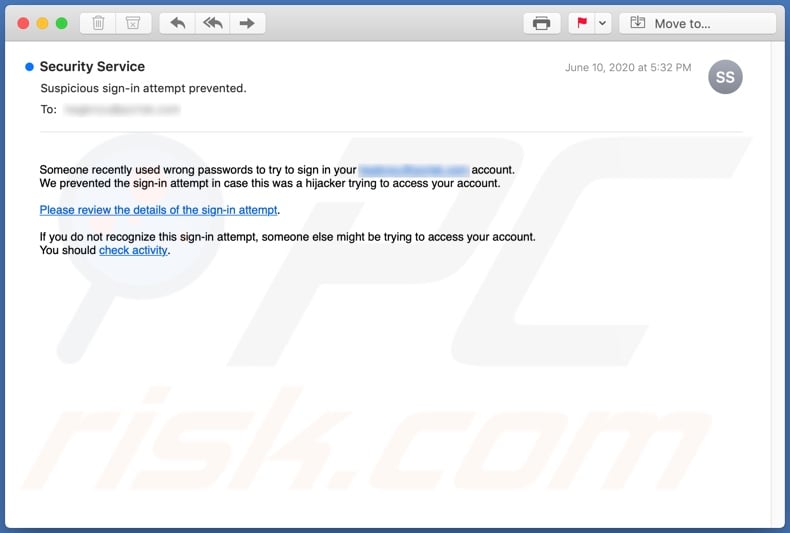
The scam messages state that someone has tried to log into the recipient's email account with an incorrect password. Access has been denied, due to concerns that it was an attempt to hijack the account. Recipients are instructed that if they do not recognize this sign-in attempt, it is likely that someone had been trying to steal their email accounts.
Users are asked to review the details of this activity. These messages have two links: if "Please review the details of the sign-in attempt" or "check activity" is clicked, users are redirected to a dubious website (e.g. oawhaursaith.com) including sale-oriented, rogue/untrusted, compromised, deceptive/scam and malicious sites.
Visiting these web pages can lead to serious issues. For example, sale-based/promotional pages can offer nonoperational, untrusted or malicious software by presenting it as useful products. Untrusted websites often host intrusive ads, which redirect to other harmful sites and can even stealthily download/install Potentially Unwanted Applications (PUAs).
Some scam sites offer fake prizes or make "unbelievable" offers to trick users into revealing personal information (e.g. names, addresses, emails, banking account or credit card details, etc.) and/or encourage them into paying fake fees.
Other deceptive web pages warn of fake viruses or outdated software, and they endorse PUAs (e.g. fake anti-viruses, adware, browser hijackers, etc.) and malware (e.g. Trojans, ransomware, cryptominers, etc.).
In summary, trusting "Suspicious sign-in attempt prevented" emails and the websites they promote can lead to system infections, financial loss, severe privacy issues and even identity theft.
| Name | Suspicious sign-in attempt prevented Email Scam. |
| Threat Type | Phishing, Scam, Social Engineering, Fraud. |
| Fake Claim | Recent log-in attempts were blocked, due to suspicions that it was an attempt to steal the user's email account. |
| Related Domains | oawhaursaith.com and various others. |
| Symptoms | Unauthorized online purchases, changed online account passwords, identity theft, illegal access of the computer. |
| Distribution methods | Deceptive emails, rogue online pop-up ads, search engine poisoning techniques, misspelled domains. |
| Damage | Loss of sensitive private information, monetary loss, identity theft. |
| Malware Removal (Windows) |
To eliminate possible malware infections, scan your computer with legitimate antivirus software. Our security researchers recommend using Combo Cleaner. Download Combo CleanerTo use full-featured product, you have to purchase a license for Combo Cleaner. 7 days free trial available. Combo Cleaner is owned and operated by RCS LT, the parent company of PCRisk.com. |
Deceptive/Scam emails are sent by the thousand, during large scale operations called "spam campaigns". "Your Google Ads account has been suspended", "Your local network has been compromised", and "Tokyo Olympics 2020" are some examples of other scam emails.
These messages are typically presented as "important", "official", "urgent" and similar. Deceptive mail is also used for phishing and malware proliferation. Regardless of what these messages claim, offer, request or demand, the purpose is identical: to generate revenue for the scammers/cyber criminals behind them.
How do spam campaigns infect computers?
Systems are infected via dangerous files distributed through spam campaigns. The emails can have download links of infectious files or, alternatively, the files can be attached to the messages. Malicious files can be in various formats such as Microsoft Office and PDF documents, archives (ZIP, RAR, etc.), executables (.exe, .run, etc.), JavaScript, etc.
When they are executed, run or otherwise opened, the infection process is triggered. Once opened, these files begin downloading/installing malware. For example, Microsoft Office documents infect systems by executing malicious macro commands. In MS Office versions released prior to 2010, this process is initiated when the document is opened.
Newer versions have "Protected View" mode, which prevents macros from being executed automatically. I.e., when users open a document in versions released after 2010, they are prompted to enable macro commands manually (i.e. to enable editing/content).
How to avoid installation of malware
To avoid infecting systems with malware distributed through spam campaigns, do not open suspicious or irrelevant emails. Any attachments or links found in dubious mail must not be opened, as this a potential source of high-risk infections. Additionally, you are advised to use Microsoft Office versions released after 2010.
Malware is also proliferated via untrusted download channels (e.g. unofficial and free file-hosting websites, Peer-to-Peer sharing networks and other third party downloaders), illegal activation ("cracking") tools and bogus updaters.
Therefore, it is important to only download from official/verified sources, and activate and update products with tools/functions provided by legitimate developers. To ensure device integrity and user safety, it is crucial to have a reputable anti-virus/anti-spyware suite installed and kept up to date.
Furthermore, use this software for regular system scans and to remove detected threats. If you have already opened malicious attachments, we recommend running a scan with Combo Cleaner Antivirus for Windows to automatically eliminate infiltrated malware.
Text presented in the "Suspicious sign-in attempt prevented" email message:
Subject: Suspicious sign-in attempt prevented.
Someone recently used wrong passwords to try to sign in your - account.
We prevented the sign-in attempt in case this was a hijacker trying to access your account.
Please review the details of the sign-in attempt.
If you do not recognize this sign-in attempt, someone else might be trying to access your account.
You should check activity.
"Suspicious sign-in attempt prevented" scam email redirecting to oawhaursaith.com (GIF):
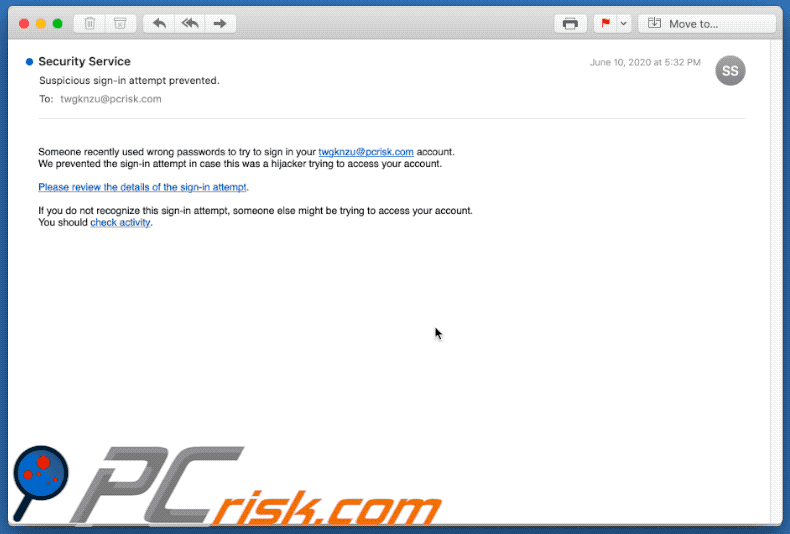
"Suspicious sign-in attempt prevented" scam email redirecting to another dubious website (GIF):
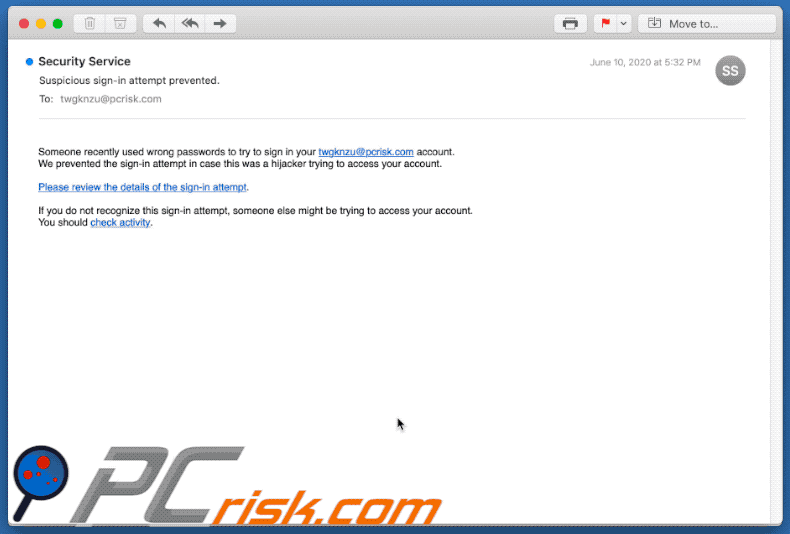
Other examples of suspicious sign-in-themed spam emails promoting phishing sites:
Sample 1:
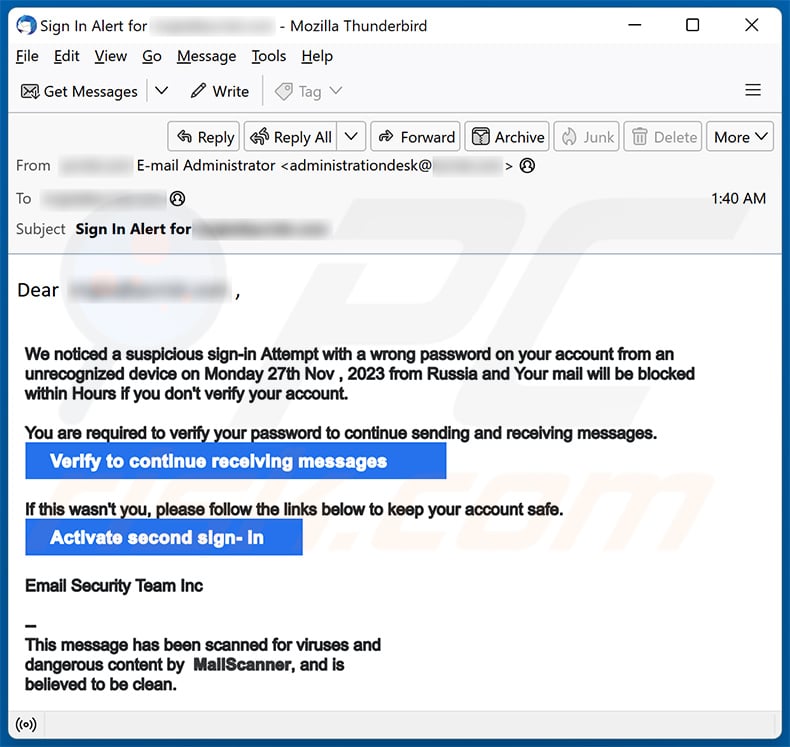
Text presented within:
Subject: Sign In Alert for ********
Dear ******** ,
We noticed a suspicious sign-in Attempt with a wrong password on your account from an unrecognized device on Monday 27th Nov , 2023 from Russia and Your mail will be blocked within Hours if you don't verify your account.
You are required to verify your password to continue sending and receiving messages.
Verify to continue receiving messagesIf this wasn't you, please follow the links below to keep your account safe.
Activate second sign- inEmail Security Team Inc
--
This message has been scanned for viruses and
dangerous content by MailScanner, and is
believed to be clean.
Screenshot of the promoted phishing site:
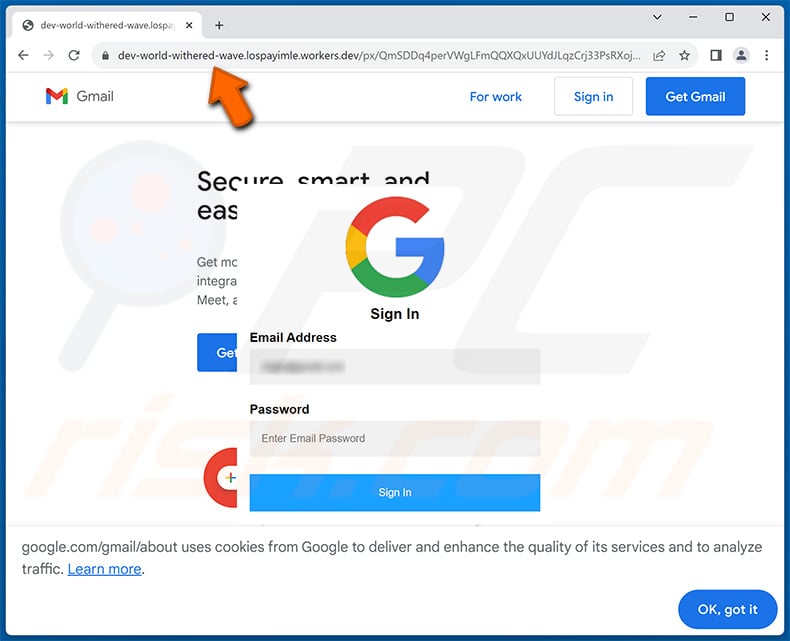
Sample 2:
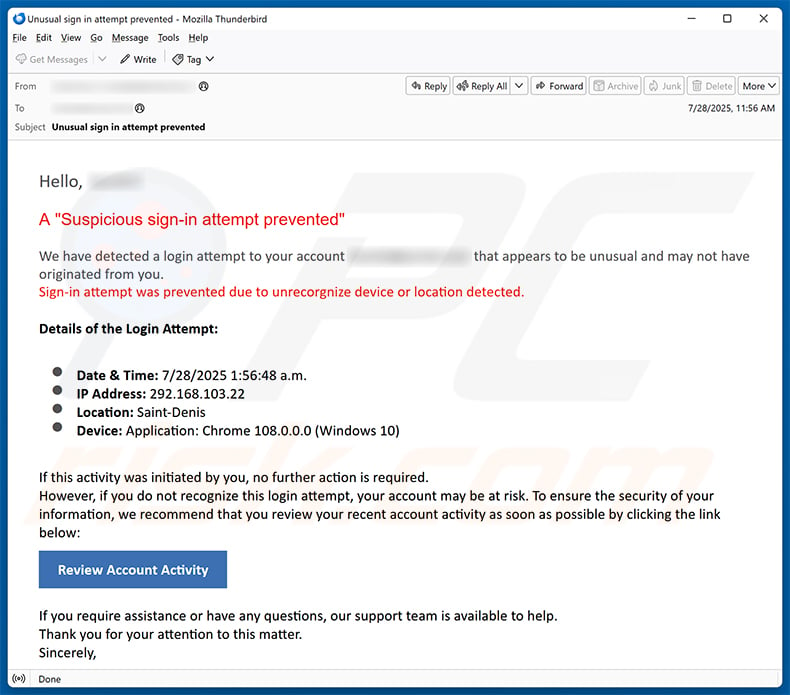
Text presented within:
Subject: Unusual sign in attempt prevented
Hello, ********!
A "Suspicious sign-in attempt prevented"
We have detected a login attempt to your account ******** that appears to be unusual and may not have originated from you.
Sign-in attempt was prevented due to unrecorgnize device or location detected.Details of the Login Attempt:
Date & Time: 7/28/2025 1:56:48 a.m.
IP Address: 292.168.103.22
Location: Saint-Denis
Device: Application: Chrome 108.0.0.0 (Windows 10)
If this activity was initiated by you, no further action is required.
However, if you do not recognize this login attempt, your account may be at risk. To ensure the security of your information, we recommend that you review your recent account activity as soon as possible by clicking the link below:
Review Account ActivityIf you require assistance or have any questions, our support team is available to help.
Thank you for your attention to this matter.
Sincerely,
Security Team
******** Hosting.
Instant automatic malware removal:
Manual threat removal might be a lengthy and complicated process that requires advanced IT skills. Combo Cleaner is a professional automatic malware removal tool that is recommended to get rid of malware. Download it by clicking the button below:
DOWNLOAD Combo CleanerBy downloading any software listed on this website you agree to our Privacy Policy and Terms of Use. To use full-featured product, you have to purchase a license for Combo Cleaner. 7 days free trial available. Combo Cleaner is owned and operated by RCS LT, the parent company of PCRisk.com.
Quick menu:
- What is Suspicious Sign-In Attempt Prevented spam?
- Types of malicious emails.
- How to spot a malicious email?
- What to do if you fell for an email scam?
Types of malicious emails:
![]() Phishing Emails
Phishing Emails
Most commonly, cybercriminals use deceptive emails to trick Internet users into giving away their sensitive private information, for example, login information for various online services, email accounts, or online banking information.
Such attacks are called phishing. In a phishing attack, cybercriminals usually send an email message with some popular service logo (for example, Microsoft, DHL, Amazon, Netflix), create urgency (wrong shipping address, expired password, etc.), and place a link which they hope their potential victims will click on.
After clicking the link presented in such email message, victims are redirected to a fake website that looks identical or extremely similar to the original one. Victims are then asked to enter their password, credit card details, or some other information that gets stolen by cybercriminals.
![]() Emails with Malicious Attachments
Emails with Malicious Attachments
Another popular attack vector is email spam with malicious attachments that infect users' computers with malware. Malicious attachments usually carry trojans that are capable of stealing passwords, banking information, and other sensitive information.
In such attacks, cybercriminals' main goal is to trick their potential victims into opening an infected email attachment. To achieve this goal, email messages usually talk about recently received invoices, faxes, or voice messages.
If a potential victim falls for the lure and opens the attachment, their computers get infected, and cybercriminals can collect a lot of sensitive information.
While it's a more complicated method to steal personal information (spam filters and antivirus programs usually detect such attempts), if successful, cybercriminals can get a much wider array of data and can collect information for a long period of time.
![]() Sextortion Emails
Sextortion Emails
This is a type of phishing. In this case, users receive an email claiming that a cybercriminal could access the webcam of the potential victim and has a video recording of one's masturbation.
To get rid of the video, victims are asked to pay a ransom (usually using Bitcoin or another cryptocurrency). Nevertheless, all of these claims are false - users who receive such emails should ignore and delete them.
How to spot a malicious email?
While cyber criminals try to make their lure emails look trustworthy, here are some things that you should look for when trying to spot a phishing email:
- Check the sender's ("from") email address: Hover your mouse over the "from" address and check if it's legitimate. For example, if you received an email from Microsoft, be sure to check if the email address is @microsoft.com and not something suspicious like @m1crosoft.com, @microsfot.com, @account-security-noreply.com, etc.
- Check for generic greetings: If the greeting in the email is "Dear user", "Dear @youremail.com", "Dear valued customer", this should raise suspiciousness. Most commonly, companies call you by your name. Lack of this information could signal a phishing attempt.
- Check the links in the email: Hover your mouse over the link presented in the email, if the link that appears seems suspicious, don't click it. For example, if you received an email from Microsoft and the link in the email shows that it will go to firebasestorage.googleapis.com/v0... you shouldn't trust it. It's best not to click any links in the emails but to visit the company website that sent you the email in the first place.
- Don't blindly trust email attachments: Most commonly, legitimate companies will ask you to log in to their website and to view any documents there; if you received an email with an attachment, it's a good idea to scan it with an antivirus application. Infected email attachments are a common attack vector used by cybercriminals.
To minimise the risk of opening phishing and malicious emails we recommend using Combo Cleaner Antivirus for Windows.
Example of a spam email:

What to do if you fell for an email scam?
- If you clicked on a link in a phishing email and entered your password - be sure to change your password as soon as possible. Usually, cybercriminals collect stolen credentials and then sell them to other groups that use them for malicious purposes. If you change your password in a timely manner, there's a chance that criminals won't have enough time to do any damage.
- If you entered your credit card information - contact your bank as soon as possible and explain the situation. There's a good chance that you will need to cancel your compromised credit card and get a new one.
- If you see any signs of identity theft - you should immediately contact the Federal Trade Commission. This institution will collect information about your situation and create a personal recovery plan.
- If you opened a malicious attachment - your computer is probably infected, you should scan it with a reputable antivirus application. For this purpose, we recommend using Combo Cleaner Antivirus for Windows.
- Help other Internet users - report phishing emails to Anti-Phishing Working Group, FBI’s Internet Crime Complaint Center, National Fraud Information Center and U.S. Department of Justice.
Share:

Tomas Meskauskas
Expert security researcher, professional malware analyst
I am passionate about computer security and technology. I have an experience of over 10 years working in various companies related to computer technical issue solving and Internet security. I have been working as an author and editor for pcrisk.com since 2010. Follow me on Twitter and LinkedIn to stay informed about the latest online security threats.
PCrisk security portal is brought by a company RCS LT.
Joined forces of security researchers help educate computer users about the latest online security threats. More information about the company RCS LT.
Our malware removal guides are free. However, if you want to support us you can send us a donation.
DonatePCrisk security portal is brought by a company RCS LT.
Joined forces of security researchers help educate computer users about the latest online security threats. More information about the company RCS LT.
Our malware removal guides are free. However, if you want to support us you can send us a donation.
Donate
▼ Show Discussion